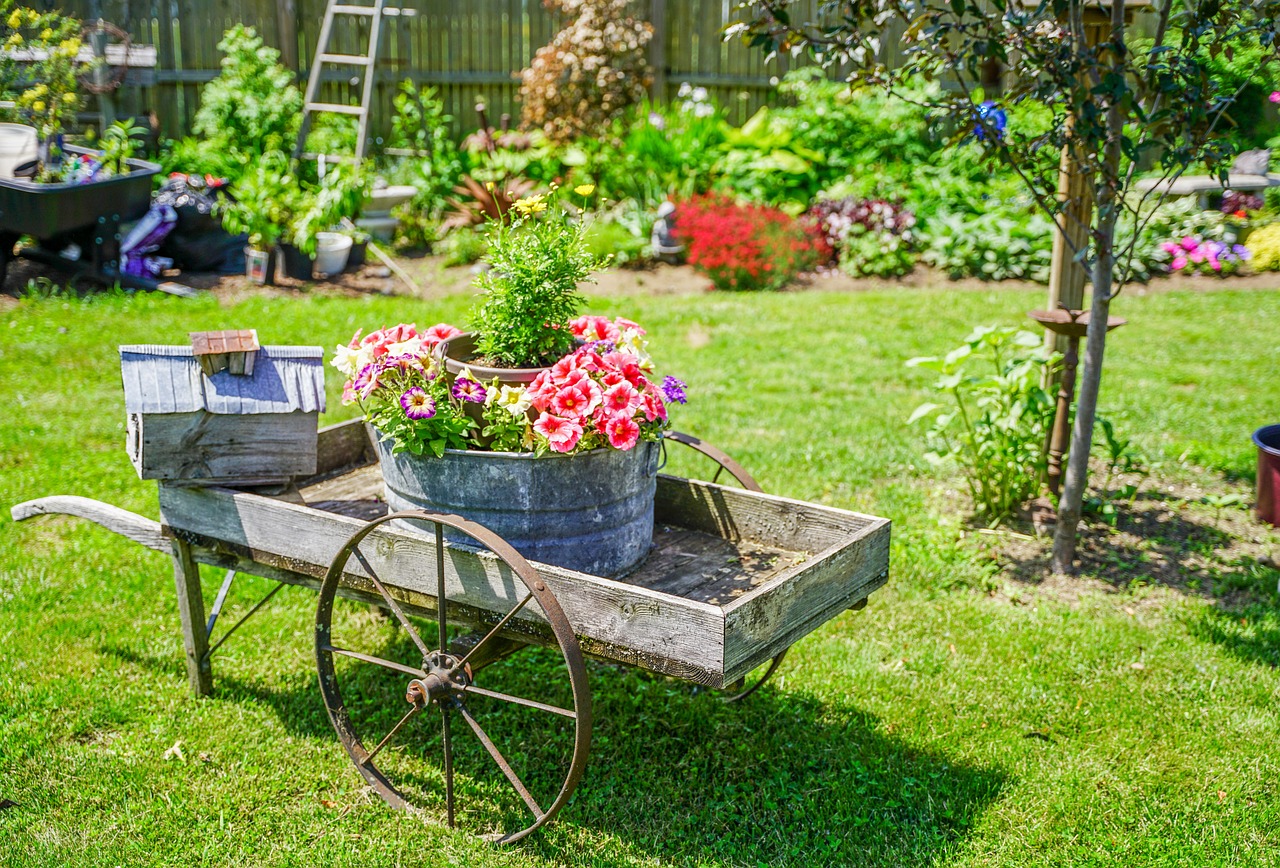How to Create a Gardening Journal
Creating a gardening journal is not just about keeping notes; it's like crafting a personal chronicle of your green thumb journey. Imagine flipping through a book that captures the essence of every seed sown, every bloom that flourished, and even the occasional mishap that left you scratching your head. A gardening journal is your best friend in the garden, providing a space to document your experiences, reflect on your successes, and learn from your challenges. It’s like having a roadmap that guides you through the seasons, helping you to cultivate not just your plants, but your gardening skills as well.
So, how do you start this exciting journey? First, you need to understand the benefits of keeping a gardening journal. Not only does it help you track plant growth and seasonal changes, but it also allows you to reflect on your gardening experiences, both good and bad. Think of it as a treasure chest of knowledge that you can refer back to in future seasons. Over time, you’ll find that your journal becomes an invaluable resource, helping you to improve your gardening techniques and make informed decisions based on past experiences.
Next, let’s dive into the essential components that should be included in your gardening journal. A well-rounded journal will have sections for plant records, weather observations, pest management, and personal reflections. By organizing your thoughts and information in this way, you’ll create a comprehensive guide that covers all aspects of your gardening journey. It’s like building a toolkit—each tool serves a purpose, and together, they help you tackle any gardening project that comes your way.
When it comes to plant records, it’s crucial to maintain detailed notes. This includes documenting the variety of each plant and its specific location in your garden. Why is this important? Well, understanding which plants thrive in certain areas can help you make better choices in the future. Additionally, regularly noting growth progress allows you to identify patterns, enabling you to optimize your watering, fertilization, and pruning practices. It’s all about being proactive rather than reactive, which can save you time and effort down the line.
Another vital section is weather observations. The weather plays a significant role in gardening, affecting everything from plant growth to pest activity. By recording weather patterns and conditions, you can anticipate challenges such as frost, drought, or excessive rainfall. This knowledge empowers you to make informed decisions, ensuring that your plants receive the care they need to thrive, regardless of the weather outside.
Now that you have a grasp on the components, let’s talk about tips for maintaining your gardening journal. Consistency is key! Set aside time regularly—perhaps weekly or after a gardening session—to update your entries. This habit will ensure you capture valuable insights and experiences throughout the growing season. Think of it as a ritual; the more you commit to it, the more rewarding it becomes.
When it comes to choosing the right format for your journal, consider whether you prefer a digital or physical journal. Each has its advantages. A digital journal can be easily edited and organized, while a physical journal offers a tactile experience that many gardeners cherish. Ultimately, the choice is yours, but make sure it aligns with how you plan to use your journal for maximum effectiveness.
Lastly, don’t forget to incorporate visuals into your journal. Adding photos, sketches, or diagrams can enhance your documentation, providing visual references that complement your written observations. This not only makes your journal more engaging but also helps you remember the beauty of your garden as it evolves over time.
- What should I include in my gardening journal? Aim to include plant records, weather observations, pest management notes, and personal reflections.
- How often should I update my gardening journal? Regular updates are essential; consider doing it weekly or after significant gardening activities.
- Is a digital or physical journal better? It depends on personal preference. Choose the format that you feel most comfortable with and that suits your gardening style.
- Can I use my gardening journal for other purposes? Absolutely! Many gardeners also use their journals for planning, sketching garden layouts, or even recording recipes for the produce they grow.

Benefits of Keeping a Gardening Journal
This article provides a comprehensive guide on establishing a gardening journal, including its benefits, essential components, and tips for maintaining it effectively to enhance your gardening experience.
Keeping a gardening journal is like having a personal assistant dedicated to your green thumb! It offers a treasure trove of advantages that can elevate your gardening game to new heights. Imagine being able to track your plants’ growth, document seasonal changes, and reflect on your gardening triumphs and tribulations. Over time, this practice not only sharpens your skills but also deepens your connection with nature.
One of the most significant benefits is the ability to track plant growth. By recording the progress of your plants, you can spot trends and patterns. For instance, you might notice that your tomatoes thrive in a specific spot, while your herbs prefer a bit more shade. This knowledge allows you to make informed decisions in future gardening seasons, optimizing your garden's layout for maximum productivity.
Furthermore, a gardening journal serves as a reflection tool. When you jot down your thoughts about the successes and challenges you face, you create a roadmap of your gardening journey. This reflection can be incredibly rewarding; it’s like flipping through a photo album filled with memories of your garden's evolution. You can celebrate your victories, learn from your mistakes, and even find inspiration for new projects.
Additionally, documenting seasonal changes in your garden can help you anticipate and adapt to the challenges that come with each new season. For example, if you note that your area experiences late frosts, you can plan to protect your tender plants accordingly. This proactive approach can save you time, effort, and heartache, ensuring that your garden remains vibrant and productive.
Here’s a quick summary of the benefits of keeping a gardening journal:
- Track plant growth: Understand how different plants perform in various conditions.
- Reflect on successes and challenges: Learn from past experiences to improve future gardening efforts.
- Document seasonal changes: Prepare for seasonal challenges and adapt your strategies accordingly.
In essence, a gardening journal is more than just a notebook; it’s a powerful tool that transforms your gardening experience into a structured and insightful adventure. So, grab that pen and paper (or open your favorite app) and start documenting your journey today!
To create an effective gardening journal, include sections for plant records, weather observations, pest management, and personal reflections, ensuring a well-rounded approach to documenting your gardening journey.
Maintaining detailed plant records helps you track the growth, health, and flowering times of your plants, allowing for better planning and care in future gardening seasons.
Documenting the variety of each plant and its specific location in your garden can aid in understanding which plants thrive best in particular areas and conditions.
Regularly noting growth progress enables you to identify patterns and make informed decisions regarding watering, fertilization, and pruning to optimize plant health.
Recording weather patterns and conditions can significantly influence your gardening strategies, helping you anticipate challenges like frost, drought, or excessive rainfall.
Consistency is key when maintaining a gardening journal. Set aside time regularly to update your entries, ensuring you capture valuable insights and experiences throughout the growing season.
Deciding between a digital or physical journal can impact your journaling experience. Consider your preferences and how you plan to use the journal for maximum effectiveness.
Adding photos, sketches, or diagrams to your journal can enhance your documentation, providing visual references that complement your written observations and notes.
Q: What should I include in my gardening journal?
A: Include sections for plant records, weather observations, pest management, and personal reflections.
Q: How often should I update my gardening journal?
A: Try to update it regularly, ideally after each gardening session or at least once a week.
Q: Can I use a digital format for my gardening journal?
A: Absolutely! Choose a format that feels comfortable for you, whether it’s digital or physical.

Essential Components of a Gardening Journal
Creating a gardening journal is like crafting a personal map of your green adventures. It’s not just about jotting down what you planted; it’s about capturing the essence of your gardening journey. To make your journal truly effective, there are several essential components you should consider including. Each section plays a crucial role in helping you reflect on your experiences and improve your gardening skills over time.
First and foremost, plant records are the backbone of any gardening journal. These records allow you to track the growth, health, and flowering times of your plants. By maintaining detailed notes, you can look back and see what worked and what didn’t, which is invaluable for future planting seasons. For instance, you might want to record:
- The variety of each plant
- The specific location in your garden
- Any special care instructions or observations
Next up, we have weather observations. Weather can be unpredictable, and keeping track of conditions such as rainfall, temperature, and frost dates can significantly influence your gardening strategies. Imagine being able to predict when a late frost might hit or when the best time to plant your tomatoes is! By documenting these patterns, you can make informed decisions that will help you avoid common pitfalls.
Another important section to include is pest management. Keeping a record of pests you encounter, along with the methods you used to manage them, can save you time and frustration in the long run. You might even want to create a simple table to summarize your findings:
| Pest | Observation Date | Control Method | Effectiveness |
|---|---|---|---|
| aphids | March 15 | Neem oil spray | Moderate success |
| slugs | April 10 | Beer traps | Highly effective |
Lastly, don’t forget to include a section for personal reflections. This is your space to express your thoughts, feelings, and lessons learned throughout the gardening season. Maybe you had a particularly challenging day, or perhaps you discovered a new technique that worked wonders. Writing down these experiences will not only enrich your journal but also provide a sense of fulfillment and growth as a gardener.
In conclusion, a well-rounded gardening journal should consist of plant records, weather observations, pest management, and personal reflections. Each of these components contributes to a holistic understanding of your gardening practices and helps you cultivate your skills over time. So, grab your favorite notebook or digital app, and start documenting your journey today!
Q: How often should I update my gardening journal?
A: It's best to update your journal regularly, ideally after each gardening session or at least once a week to capture all the important details.
Q: Can I use a digital format for my gardening journal?
A: Absolutely! Digital journals can be very convenient, allowing for easy edits, photos, and even cloud backup for your records.
Q: What should I do if I miss a few entries?
A: Don’t stress! Just pick up where you left off. You can always summarize what you remember or focus on the present and future entries.

Plant Records
When it comes to nurturing your green thumb, maintaining detailed is like having a roadmap to success. Imagine embarking on a grand journey without a map; you might find yourself lost, wandering aimlessly. Similarly, without a comprehensive record of your plants, you could miss out on vital insights that could elevate your gardening game to new heights. Keeping track of each plant's growth, health, and flowering times allows you to make informed decisions that can significantly impact your garden's overall success.
One of the most critical aspects of your plant records is documenting the variety of each plant and its specific location in your garden. This information acts as a guide, helping you understand which plants thrive best in particular areas and conditions. For instance, if you notice that your tomatoes flourish in a sunny corner while your ferns prefer the shade, you can strategically plan your planting for the following season. This not only maximizes your garden's potential but also minimizes the guesswork involved in plant care.
Another essential element of your plant records is tracking growth progress. Regularly noting how your plants are developing can reveal patterns that inform your gardening practices. Are your roses blooming earlier than last year? Is the basil growing taller but looking a bit leggy? These observations can lead to crucial decisions regarding watering, fertilization, and pruning. For example, if you notice that your plants are not thriving, you might consider adjusting their watering schedule or experimenting with different fertilizers. Your records will serve as a valuable reference, allowing you to look back and learn from past experiences.
To make your plant records even more effective, consider creating a simple table to organize your notes. Here’s an example layout:
| Plant Variety | Location | Growth Progress | Notes |
|---|---|---|---|
| Tomato | Sunny Corner | Growing well, flowers appear | Water every 3 days |
| Basil | Near the fence | Leggy, needs pruning | Fertilize weekly |
This table not only organizes your information but also makes it easy to review and compare your plants at a glance. The more detailed and structured your records, the more equipped you'll be to tackle any gardening challenges that come your way.
In conclusion, keeping meticulous plant records is an invaluable practice for any gardener. It empowers you with knowledge, enhances your decision-making skills, and ultimately leads to a more successful and fulfilling gardening experience. So grab that notebook or open up a digital document and start documenting your plant journey today!
Q: How often should I update my plant records?
A: It's best to update your records regularly, ideally every week or after significant changes in your plants' growth or health.
Q: Can I use a digital app for my gardening journal?
A: Absolutely! There are many gardening apps available that can help you track your plants digitally, offering features like reminders and photo uploads.
Q: What if I forget to document something?
A: Don't worry! Gardening is about learning and growing. Just make a note of it when you remember, and try to be more consistent moving forward.

Variety and Location
When it comes to gardening, understanding the variety of each plant and its specific location in your garden can make all the difference. Think of your garden as a puzzle where each piece has its unique shape and place. If you can identify which plants fit best in which spots, you’ll create a thriving ecosystem that flourishes year after year. It's all about matching the right plant with the right environment!
For instance, some plants love the sun while others prefer the shade. By documenting the variety and location of your plants, you can start to see patterns emerge. You might discover that your tomatoes are producing better in that sunny corner of the garden, while your ferns thrive in the cooler, shadier spots. This knowledge will not only enhance your current gardening practices but also help you make informed decisions in future planting seasons.
Consider creating a simple table in your gardening journal to organize this information. Here’s a sample layout:
| Plant Variety | Location in Garden | Sun/Shade Preference | Notes |
|---|---|---|---|
| Tomato | South Corner | Full Sun | Best yield observed in 2023 |
| Fern | North Side | Partial Shade | Thrives with less water |
| Lavender | West Bed | Full Sun | Attracts pollinators |
By keeping track of these details, you can refine your gardening approach. You’ll not only learn which plants are best suited for your garden's microclimates, but you’ll also gain insights into how to care for them more effectively. Additionally, this practice can help you avoid repeating mistakes from previous seasons, like planting sun-loving flowers in shaded areas or water-hungry plants in dry spots. It’s all about creating a harmonious balance in your garden!
So, the next time you plant something new, take a moment to jot down its variety and where you’ve placed it. You’ll be amazed at how this simple practice can transform your gardening experience. Plus, when you look back at your journal, you’ll appreciate the journey of growth—not just for your plants, but for your skills as a gardener.
- What should I include in my gardening journal? Aim to document plant varieties, growth progress, weather observations, and personal reflections.
- Is it better to keep a digital or physical gardening journal? It depends on your personal preference! Digital journals can be easily edited and stored, while physical journals can be more personal and tactile.
- How often should I update my gardening journal? Consistency is key! Try to set aside time weekly or bi-weekly to capture your gardening experiences.

Growth Progress
Tracking the of your plants is like keeping a diary of their journey from tiny seeds to flourishing beauties. It’s a fascinating process that not only helps you understand how your plants are thriving but also allows you to make informed decisions about their care. Imagine watching a plant grow, almost like witnessing a child develop; each stage brings new challenges and joys. By regularly documenting growth, you can identify patterns that will serve you well in future gardening endeavors.
One effective way to track growth is by noting the changes in height, leaf size, and overall health of your plants. For instance, if you’re growing tomatoes, you might record their height every week, noting when they start to flower or produce fruit. This information is invaluable for planning your gardening activities, such as when to fertilize or prune. You could create a simple table in your journal to organize this data:
| Date | Plant Variety | Height (inches) | Notes |
|---|---|---|---|
| April 1 | Cherry Tomato | 6 | Healthy leaves, no flowers yet |
| April 15 | Cherry Tomato | 12 | First flowers appearing |
| May 1 | Cherry Tomato | 18 | Fruits starting to form |
Additionally, it’s crucial to note any changes in your plants' environment, such as shifts in sunlight or water availability. For example, if you moved your plants to a sunnier spot, jot down how that affects their growth. Are they growing faster? Are the leaves turning a brighter green? These observations can help you adjust your gardening practices to optimize plant health.
Moreover, keeping track of growth progress allows you to celebrate your successes. There’s something incredibly rewarding about looking back at your notes and seeing how far your plants have come. It’s like flipping through an old photo album, reminiscing about the challenges you faced and the victories you achieved. By reflecting on these moments, you not only enhance your gardening skills but also deepen your connection with nature.
In conclusion, documenting growth progress is an essential component of maintaining a gardening journal. It provides you with a wealth of information that can improve your gardening practices and foster a greater appreciation for the plants you nurture. So, grab that pen or open up your favorite gardening app, and start capturing the beautiful journey of your plants!
- Why should I keep a gardening journal? Keeping a gardening journal helps you track your plants' growth, document seasonal changes, and reflect on your gardening successes and challenges.
- What should I include in my gardening journal? Include sections for plant records, weather observations, pest management, and personal reflections.
- How often should I update my gardening journal? Consistency is key—try to update your journal regularly, ideally after each gardening session.
- Can I use digital tools for my gardening journal? Absolutely! Whether you prefer a physical journal or a digital format, choose what works best for you.
- What are some creative ways to enhance my gardening journal? Incorporating visuals like photos, sketches, or diagrams can greatly enrich your documentation.

Weather Observations
When it comes to gardening, the weather is like the unpredictable guest at a party—sometimes it brings the fun, and other times it can cause chaos. Keeping a close eye on weather patterns is essential for any gardener who wants to thrive. By documenting weather observations in your gardening journal, you can make informed decisions that will help your plants flourish. Imagine being able to anticipate a sudden frost or knowing when to water your garden based on recent rainfall. It’s like having a crystal ball for your garden!
Start by noting daily temperatures, rainfall amounts, and any unusual weather events. This information can help you understand how different plants react to various conditions. For instance, some plants may thrive in the heat while others might struggle. By tracking this data, you can identify trends over time. You might find that your tomatoes do exceptionally well during a warm, dry spell, while your ferns prefer cooler, wetter conditions. This insight is gold for any gardener looking to optimize their garden layout.
Consider creating a simple table in your journal to record your weather observations. Here’s a basic example:
| Date | Temperature (°F) | Rainfall (inches) | Notes |
|---|---|---|---|
| April 1 | 65 | 0.5 | Sunny, good day for planting. |
| April 2 | 70 | 0.0 | Warm and dry, check on watering schedule. |
| April 3 | 55 | 1.2 | Cool front came in, protect seedlings. |
This table allows you to quickly glance at how weather changes affect your gardening decisions. Additionally, you can jot down any significant weather events, like storms or heatwaves, in the 'Notes' section. This practice not only enriches your gardening journal but also enhances your understanding of the climate’s impact on your garden.
Moreover, don't forget to observe the microclimates in your garden. These are small areas that may have different weather conditions than the surrounding environment. For example, a spot sheltered by trees may remain cooler and wetter than a sunny patch. By paying attention to these nuances and recording them, you can tailor your gardening practices to suit each specific area, ensuring that every plant gets the best care possible.
In conclusion, keeping detailed weather observations in your gardening journal is a powerful tool that can elevate your gardening game. Not only does it help you react to immediate weather changes, but it also provides valuable historical data that can guide your future gardening endeavors. So, grab that pen or open your digital device, and start documenting the weather. Your plants will thank you!
- Why is it important to track weather in a gardening journal?
Tracking weather helps you understand how different plants respond to various conditions, allowing you to make informed decisions for better plant care.
- What specific weather details should I record?
Consider recording daily temperatures, rainfall amounts, humidity levels, and any unusual weather events that may affect your garden.
- How can I use weather observations to improve my gardening?
By analyzing weather patterns, you can optimize watering schedules, plant placement, and even choose the right plants for your garden based on their climate preferences.

Tips for Maintaining Your Gardening Journal
This article provides a comprehensive guide on establishing a gardening journal, including its benefits, essential components, and tips for maintaining it effectively to enhance your gardening experience.
A gardening journal offers numerous advantages, such as tracking plant growth, documenting seasonal changes, and reflecting on gardening successes and challenges, ultimately improving your gardening skills over time.
To create an effective gardening journal, include sections for plant records, weather observations, pest management, and personal reflections, ensuring a well-rounded approach to documenting your gardening journey.
Maintaining detailed plant records helps you track the growth, health, and flowering times of your plants, allowing for better planning and care in future gardening seasons.
Documenting the variety of each plant and its specific location in your garden can aid in understanding which plants thrive best in particular areas and conditions.
Regularly noting growth progress enables you to identify patterns and make informed decisions regarding watering, fertilization, and pruning to optimize plant health.
Recording weather patterns and conditions can significantly influence your gardening strategies, helping you anticipate challenges like frost, drought, or excessive rainfall.
Consistency is key when maintaining a gardening journal. Set aside time regularly to update your entries, ensuring you capture valuable insights and experiences throughout the growing season. Think of your gardening journal as a living organism; it needs regular care and attention to thrive. By dedicating a specific time each week—perhaps during your morning coffee or after a long day in the garden—you create a routine that makes journaling a natural part of your gardening practice.
When it comes to choosing the right format for your journal, consider your personal preferences. Some gardeners prefer the tactile experience of writing in a physical notebook, where they can doodle and sketch freely. Others might lean towards a digital format, which can be easily updated and organized. Both options have their merits, and the best choice often comes down to how you envision using your journal. For example, a digital journal can include hyperlinks to gardening resources or images of your plants, while a physical journal allows for a more personal touch with handwritten notes and sketches.
Incorporating visuals into your journal can significantly enhance your documentation. Consider adding photos of your plants at various stages of growth, or even sketches of your garden layout. These visuals not only serve as a delightful reminder of your garden's evolution but also provide a quick reference for future gardening endeavors. You might want to create a section in your journal dedicated to visuals, which could include:
- Photos of blooming plants
- Sketches of garden designs
- Diagrams of pest management strategies
Lastly, don't forget to include personal reflections in your journal. This is where the magic happens! Write about your feelings, the challenges you faced, and the triumphs you celebrated. Reflecting on your experiences not only helps you process your gardening journey but also allows you to grow as a gardener. After all, every garden tells a story, and your journal is the perfect place to narrate it.
Q: How often should I update my gardening journal?
A: Ideally, you should update your journal at least once a week, but feel free to jot down notes whenever you have gardening thoughts or observations.
Q: Can I use a digital app for my gardening journal?
A: Absolutely! Many gardeners prefer digital apps for their convenience and ability to store images and notes in one place.
Q: What should I include in my gardening journal?
A: Include plant records, weather observations, pest management notes, and personal reflections to create a comprehensive gardening resource.

Choosing the Right Format
When it comes to creating your gardening journal, one of the first decisions you'll face is choosing the right format. This choice can significantly impact how you engage with your gardening journey. Are you more of a traditionalist who loves the feel of pen on paper, or do you prefer the convenience of digital tools? Each format has its own set of advantages and challenges, and understanding these can help you make an informed decision.
If you're leaning towards a physical journal, consider the tactile experience it offers. There's something incredibly satisfying about flipping through pages filled with your thoughts, sketches, and plant records. You can personalize it with stickers, drawings, or even pressed flowers, making it a creative outlet as well as a practical tool. However, keep in mind that a physical journal can be cumbersome to carry around, especially if you're out in the garden and want to jot down observations quickly.
On the other hand, a digital journal can offer unparalleled convenience. With apps and software designed specifically for gardening, you can easily track your plants, weather conditions, and even set reminders for watering or fertilizing. Digital formats allow for easy editing, organizing, and even sharing your gardening experiences with fellow enthusiasts. Plus, you can incorporate multimedia elements like photos and videos, which can enhance your documentation. However, the downside is that you might lose some of the personal touch that comes with a handwritten journal.
Ultimately, the best format for your gardening journal depends on your personal preferences and lifestyle. To help you decide, here are some factors to consider:
- Accessibility: Will you have easy access to your journal when you need it? Digital journals can be accessed on multiple devices, while physical journals require you to carry them around.
- Ease of Use: Are you comfortable using technology, or do you prefer the simplicity of writing things down by hand?
- Creativity: Do you enjoy doodling and adding personal touches, which might be easier in a physical format?
- Organization: How do you prefer to categorize and retrieve your notes? Digital journals often come with search functions that can save you time.
In conclusion, whether you opt for a traditional notebook or a modern app, the most important thing is to choose a format that resonates with you. After all, your gardening journal should be a reflection of your unique gardening journey, capturing the joy, challenges, and growth you experience along the way. So, take a moment to think about what format will inspire you to write and document your progress consistently. Happy journaling!
Q: Can I combine both formats?
A: Absolutely! Many gardeners find that using both a physical journal for creative expression and a digital format for organization works best for them.
Q: How often should I update my gardening journal?
A: It's best to update your journal as frequently as possible. Consider setting aside time weekly or bi-weekly to ensure you capture all relevant observations and experiences.
Q: What should I include in my gardening journal?
A: Your gardening journal can include plant records, weather observations, pest management notes, and personal reflections. It's a space for anything that helps you grow as a gardener!

Incorporating Visuals
This article provides a comprehensive guide on establishing a gardening journal, including its benefits, essential components, and tips for maintaining it effectively to enhance your gardening experience.
A gardening journal offers numerous advantages, such as tracking plant growth, documenting seasonal changes, and reflecting on gardening successes and challenges, ultimately improving your gardening skills over time.
To create an effective gardening journal, include sections for plant records, weather observations, pest management, and personal reflections, ensuring a well-rounded approach to documenting your gardening journey.
Maintaining detailed plant records helps you track the growth, health, and flowering times of your plants, allowing for better planning and care in future gardening seasons.
Documenting the variety of each plant and its specific location in your garden can aid in understanding which plants thrive best in particular areas and conditions.
Regularly noting growth progress enables you to identify patterns and make informed decisions regarding watering, fertilization, and pruning to optimize plant health.
Recording weather patterns and conditions can significantly influence your gardening strategies, helping you anticipate challenges like frost, drought, or excessive rainfall.
Consistency is key when maintaining a gardening journal. Set aside time regularly to update your entries, ensuring you capture valuable insights and experiences throughout the growing season.
Deciding between a digital or physical journal can impact your journaling experience. Consider your preferences and how you plan to use the journal for maximum effectiveness.
Incorporating visuals into your gardening journal can transform it from a simple record into a vibrant tapestry of your gardening journey. Think about it: a picture can tell a thousand words, right? By adding photos, sketches, or even diagrams, you create a more engaging and informative experience for yourself. For instance, when you document the growth of a plant over time, a series of photos can vividly illustrate its transformation, making it easier to remember the successes and challenges you faced.
Moreover, visuals can serve as a quick reference. You might include a color chart for different flower blooms or a pest identification guide that you’ve created based on your findings. This not only enhances your journal but also makes it a valuable resource for future gardening seasons. Here’s a simple table to illustrate how you might organize your visuals:
| Visual Type | Description | Date Captured |
|---|---|---|
| Photo | Blooming roses in spring | April 15, 2023 |
| Sketch | Garden layout plan | March 10, 2023 |
| Diagram | Pest lifecycle | June 5, 2023 |
In addition, consider the emotional aspect of gardening. Visuals can evoke memories and feelings associated with particular plants or seasons. A snapshot of your first harvest or a sketch of a beautiful sunset over your garden can bring back the joy of those moments, making your journal not just a record, but a cherished keepsake. So, don’t shy away from being creative! Use your journal as a canvas where you can express your gardening passion in full color.
- What should I include in my gardening journal? Aim to document plant records, weather observations, pest management strategies, and personal reflections.
- Is it better to keep a digital or physical journal? It depends on your preference! Some people enjoy the tactile experience of writing by hand, while others prefer the convenience of digital tools.
- How often should I update my gardening journal? Regular updates are essential; try to set aside time weekly or bi-weekly to reflect on your gardening experiences.
- Can I include non-plant-related entries? Absolutely! Feel free to jot down any thoughts or experiences related to gardening, such as visits to botanical gardens or workshops.
Frequently Asked Questions
- What is a gardening journal?
A gardening journal is a personal record where you document your gardening activities, observations, and experiences. It can include details about plant growth, weather patterns, pest management, and even your thoughts and reflections on your gardening journey. Think of it as a scrapbook for your garden!
- Why should I keep a gardening journal?
Keeping a gardening journal has several benefits. It helps you track the growth and health of your plants, document seasonal changes, and reflect on your successes and challenges. Over time, this practice can enhance your gardening skills, making you a more knowledgeable and effective gardener.
- What should I include in my gardening journal?
Your gardening journal should have sections for plant records, weather observations, pest management, and personal reflections. This well-rounded approach will help you capture a complete picture of your gardening journey, making it easier to learn and grow.
- How often should I update my gardening journal?
Consistency is key! Aim to update your gardening journal regularly—whether it's weekly or bi-weekly. Setting aside time to jot down your observations ensures you don't miss out on valuable insights and experiences throughout the growing season.
- Should I choose a digital or physical journal?
The choice between a digital or physical journal depends on your personal preference. Digital journals can be easily edited and organized, while physical ones allow for a more personal touch with handwritten notes and sketches. Pick the format that feels right for you!
- Can I add visuals to my gardening journal?
Absolutely! Incorporating photos, sketches, or diagrams can significantly enhance your gardening journal. Visuals provide a great way to complement your written observations and make your entries more engaging and memorable.



















